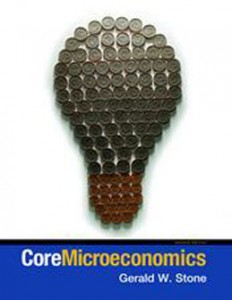Test Bank for CoreMicroeconomics, 2nd Edition: Stone

Product details:
- ISBN-10 : 1429240008
- ISBN-13 : 978-1429240000
- Author: Stone
The Core Text is a traditional textbook focusing on the core topics in economics. It includes the usual textbook apparatus, including key terms and definitions. It also includes a set of innovative end-of-chapter questions and problems, many of which have been drawn from today’s headlines and the business press.
The CourseTutor is designed for interactivity. Students must work through the CourseTutor with a pencil in hand, reading through tutorials, solving problems, and drawing graphs. Short quizzes help students assess their progress and suggest additional work to help them master concepts.
Table contents:
- 1—The capitalist revolution
- Introduction
- 1.1 Income inequality
- 1.2 Measuring income and living standards
- 1.3 History’s hockey stick: Growth in income
- 1.4 The permanent technological revolution
- 1.5 The economy and the environment
- 1.6 Capitalism defined: Private property, markets, and firms
- 1.7 Capitalism as an economic system
- 1.8 The gains from specialization
- 1.9 Capitalism, causation and history’s hockey stick
- 1.10 Varieties of capitalism: Institutions, government, and the economy
- 1.11 Economics and the economy
- 1.12 Conclusion
- 1.13 References
- 2—Technology, population, and growth
- Introduction
- 2.1 Economists, historians, and the Industrial Revolution
- 2.2 Economic models: How to see more by looking at less
- 2.3 Basic concepts: Prices, costs, and innovation rents
- 2.4 Modelling a dynamic economy: Technology and costs
- 2.5 Modelling a dynamic economy: Innovation and profit
- 2.6 The British Industrial Revolution and incentives for new technologies
- 2.7 Malthusian economics: Diminishing average product of labour
- 2.8 Malthusian economics: Population grows when living standards rise
- 2.9 The Malthusian trap and long-term economic stagnation
- 2.10 Escaping from Malthusian stagnation
- 2.11 Conclusion
- 2.12 References
- 3—Scarcity, work, and choice
- Introduction
- 3.1 Labour and production
- 3.2 Preferences
- 3.3 Opportunity costs
- 3.4 The feasible set
- 3.5 Decision making and scarcity
- 3.6 Hours of work and economic growth
- 3.7 Income and substitution effects on hours of work and free time
- 3.8 Is this a good model?
- 3.9 Explaining our working hours: Changes over time
- 3.10 Explaining our working hours: Differences between countries
- 3.11 Conclusion
- 3.12 References
- 4—Social interactions
- Introduction
- 4.1 Social interactions: Game theory
- 4.2 Equilibrium in the invisible hand game
- 4.3 The prisoners’ dilemma
- 4.4 Social preferences: Altruism
- 4.5 Altruistic preferences in the prisoners’ dilemma
- 4.6 Public goods, free riding, and repeated interaction
- 4.7 Public good contributions and peer punishment
- 4.8 Behavioural experiments in the lab and in the field
- 4.9 Cooperation, negotiation, conflicts of interest, and social norms
- 4.10 Dividing a pie (or leaving it on the table)
- 4.11 Fair farmers, self-interested students?
- 4.12 Competition in the ultimatum game
- 4.13 Social interactions: Conflicts in the choice among Nash equilibria
- 4.14 Conclusion
- 4.15 References
- 5—Property and power: Mutual gains and conflict
- Introduction
- 5.1 Institutions and power
- 5.2 Evaluating institutions and outcomes: The Pareto criterion
- 5.3 Evaluating institutions and outcomes: Fairness
- 5.4 A model of choice and conflict
- 5.5 Technically feasible allocations
- 5.6 Allocations imposed by force
- 5.7 Economically feasible allocations and the surplus
- 5.8 The Pareto efficiency curve and the distribution of the surplus
- 5.9 Politics: Sharing the surplus
- 5.10 Bargaining to a Pareto-efficient sharing of the surplus
- 5.11 Angela and Bruno: The moral of the story
- 5.12 Measuring economic inequality
- 5.13 A policy to redistribute the surplus and raise efficiency
- 5.14 Conclusion
- 5.15 References
- 6—The firm: Owners, managers, and employees
- Introduction
- 6.1 Firms, markets, and the division of labour
- 6.2 Other people’s money: The separation of ownership and control
- 6.3 Other people’s labour
- 6.4 Employment rents
- 6.5 Determinants of the employment rent
- 6.6 Work and wages: The labour discipline model
- 6.7 Wages, effort, and profits in the labour discipline model
- 6.8 Putting the model to work: Owners, employees, and the economy
- 6.9 Another kind of business organization
- 6.10 Principals and agents: Interactions under incomplete contracts
- 6.11 Conclusion
- 6.12 References
- 7—The firm and its customers
- Introduction
- 7.1 Breakfast cereal: Choosing a price
- 7.2 Economies of scale and the cost advantages of large-scale production
- 7.3 Production: The cost function for Beautiful Cars
- 7.4 Demand and isoprofit curves: Beautiful Cars
- 7.5 Setting price and quantity to maximize profit
- 7.6 Look at profit maximization as marginal revenue and marginal cost
- 7.7 Gains from trade
- 7.8 The elasticity of demand
- 7.9 Using demand elasticities in government policy
- 7.10 Price-setting, competition, and market power
- 7.11 Product selection, innovation, and advertising
- 7.12 Prices, costs, and market failure
- 7.13 Conclusion
- 7.14 References
- 8—Supply and demand: Price-taking and competitive markets
- Introduction
- 8.1 Buying and selling: Demand and supply
- 8.2 The market and the equilibrium price
- 8.3 Price-taking firms
- 8.4 Market supply and equilibrium
- 8.5 Competitive equilibrium: Gains from trade, allocation, and distribution
- 8.6 Changes in supply and demand
- 8.7 The effects of taxes
- 8.8 The model of perfect competition
- 8.9 Looking for competitive equilibria
- 8.10 Price-setting and price-taking firms
- 8.11 Conclusion
- 8.12 References
- 9—The labour market: Wages, profits, and unemployment
- Introduction
- 9.1 The wage-setting curve, the price-setting curve, and the labour market
- 9.2 Measuring the economy: Employment and unemployment
- 9.3 The wage-setting curve: Employment and real wages
- 9.4. The firm’s hiring decision
- 9.5. The price-setting curve: Wages and profits in the whole economy
- 9.6 Wages, profits, and unemployment in the whole economy
- 9.7 How changes in demand for goods and services affect unemployment
- 9.8. Labour market equilibrium and the distribution of income
- 9.9. Labour supply, labour demand, and bargaining power
- 9.10. Labour unions: Bargained wages and the union voice effect
- 9.11 Labour market policies to address unemployment and inequality
- 9.12. Looking backward: Baristas and bread markets
- 9.13 Conclusion
- 9.14 References
- 10—Banks, money, and the credit market
- Introduction
- 10.1 Money and wealth
- 10.2 Borrowing: Bringing consumption forward in time
- 10.3 Impatience and the diminishing marginal returns to consumption
- 10.4 Borrowing allows smoothing by bringing consumption to the present
- 10.5 Lending and storing: Smoothing and moving consumption to the future
- 10.6 Investing: Another way to move consumption to the future
- 10.7 Assets, liabilities, and net worth
- 10.8 Banks, money, and the central bank
- 10.9 The central bank, the money market, and interest rates
- 10.10 The business of banking and bank balance sheets
- 10.11 The central bank’s policy rate can affect spending
- 10.12 Credit market constraints: A principal–agent problem
- 10.13 Inequality: Lenders, borrowers, and those excluded from credit markets
- 10.14 Conclusion
- 10.15 References
People also search:
CoreMicroeconomics
CoreMicroeconomics Stone
CoreMicroeconomics Stone 2nd
CoreMicroeconomics Stone 2nd Test Bank
Test Bank for CoreMicroeconomics, 2nd Edition: Stone Download





